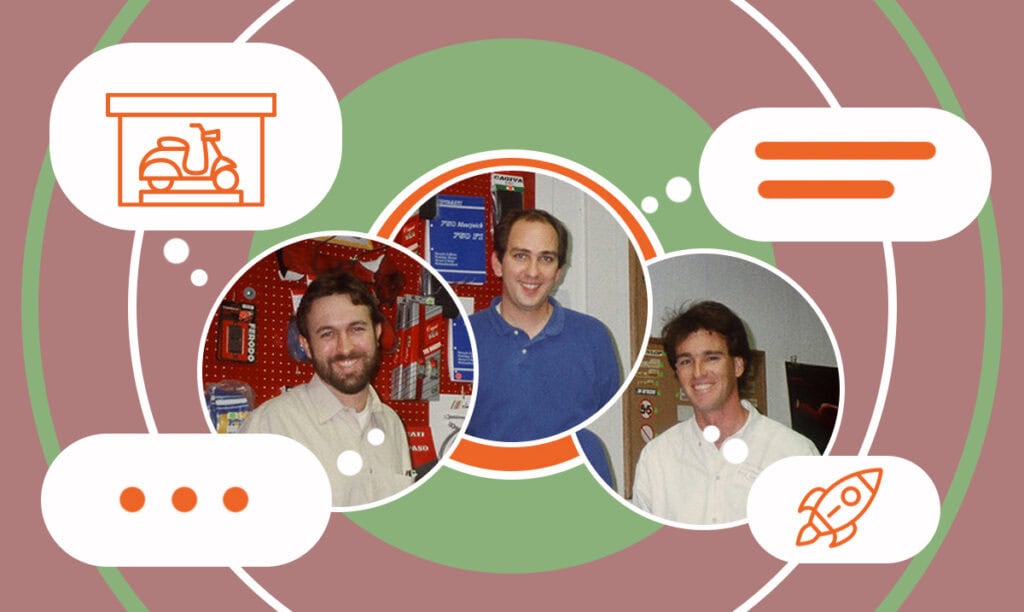Embark on a voyage through the world of catamaran entrepreneurship with Estelle and Stephen Cockcroft, seasoned veterans boasting three decades ofex ...
How Pro Italia Pioneers Success in the Motorcycle Industry
Written by: Esther Strauss
Esther is a business strategist with over 20 years of experience as an entrepreneur, executive, educator, and management advisor.
Published on May 29, 2024

In this interview, we delve into the story of Glenn Morgan, Bill Nation, and Eric Lewald, three college friends whose shared passion for motorcycles led them to the creation of Pro Italia, a renowned motorcycle dealership in California. From their beginnings in Tennessee to their successful careers in Hollywood and beyond, discover how their experiences and challenges in finding Ducati parts inspired the birth of their business. This interview offers invaluable insights for entrepreneurs and motorcycle enthusiasts eager to learn about building a business from a foundation of friendship and shared interests.

Choosing the Ideal Location
SBS – How did you choose the location for Pro Italia, and what factors made it ideal for a motorcycle dealership?
Pro Italia – We started the business when our local Ducati dealer lost his lease and shut down his dealership, so the Glendale franchise area was open. Our primary founder, Earl Campbell, lived nearby, very close to Angeles Crest Highway, which is a favorite road among motorcycle riders. A friend located the actual building for us, which was not ideal. It was a storefront travel agency, very narrow. There was alley access in the rear, but next to a pet store with outdoor rabbit kennels. Earl completely remodeled the space to make it work. (we have pictures). It’s a nice neighborhood, not where you might expect to find a motorcycle dealer, but close to two freeways, which is a big bonus. Also, an upscale neighborhood suits our brand.

By 1996, we were well established here, and we moved a couple of blocks down the street to a much larger and more accommodating building, which we later bought, both as an investment and to control our future and not lose our lease. It’s hard to find a building that both suits our needs and is zoned properly. We now also have an “annex,” two doors up the sidewalk, where we have two of our brands and used bikes.

Building Brand Relationships
SBS – What were the initial challenges in establishing relationships with major motorcycle brands, and how did you overcome them?
Pro Italia – We started with the two Italian brands — Ducati and Moto Guzzi — that the previous dealer carried. Our first idea was to just open a repair shop, but the Ducati rep at the time told us we’d have a hard time getting parts that way. Someone else would surely take over the franchise, and we’d be locked out — this was maybe a once-in-a-generation chance to get the dealership here.
We had no actual industry experience, but that Ducati rep helped us and convinced the importer that we were the right outfit to take over the franchise. Our application asked, “How many cumulative years in the motorcycle business?” The four of us looked at each other and wrote “0.” Now, the remaining three of us have well over 100 years among us. Moto Guzzi was a much smaller brand; I don’t think there was an issue there.
Inventory Management Strategies
SBS – Can you discuss your approach to inventory management, especially balancing new and pre-owned units?
Pro Italia – It’s quite a balancing act, and always fluctuating. There’s always pressure from the manufacturers for us to have more inventory in stock, and we can’t sell a bike if it’s not here. But if it doesn’t sell fairly quickly, we start paying interest on it, which is costly — currently 13% annually. It can be nerve-wracking. We have a bigger margin on used bikes, and we buy them outright, so we don’t pay interest, but we still have to make sure we buy or take in bikes that we can turn over. Storage is an issue, too. We currently have 240 bikes in inventory, 60 of which are used. That’s $2.2 million in new bikes and $485,000 in used bikes. On average, we probably have 200 in total.

Effective Marketing Techniques
SBS – What marketing strategies have proven most effective in attracting your target customers?
Pro Italia – We post all our used bikes (and some new ones) on Cycle Trader, which gets exactly the kind of traffic we’re looking for. It’s cost-effective, and we know how it’s working for us. Our website also carries photos of all our used bikes, as well as general information. We recently found a new company (a really capable guy, also a Ducati rider) to take over our social media marketing. We’re trying to emphasize what makes us special and different and not just grab someone’s attention for five seconds (see next question).

Excelling in Customer Service
SBS – How do you differentiate Pro Italia from other motorcycle dealerships in terms of customer service?
Pro Italia – We are a specialty dealer, and we are motorcycle riders and enthusiasts ourselves. Our Italian brands are relatively uncommon, and very few dealerships specialize in them. Unlike bigger dealers that carry Ducati, etc., as a sideline, it’s our only business. All our staff is knowledgeable, and we try to minimize staff turnover to maintain continuity. All our techs have been trained for the bikes they’re working on.
Our initial mission was to create the kind of dealership we were looking for as customers and riders. There can be a bit of an insider or club atmosphere, which is inclusive but different — not a cult, not a lifestyle, but a brotherhood of sorts; women are invited, too. There are other great bikes and dealerships, but you won’t meet the same kind of people as you do here.
Key Financial Metrics
SBS – What are the key financial metrics you monitor regularly to ensure the business remains profitable?
Pro Italia – First off, cash flow is everything, so we can buy used bikes to keep that pipeline full and everything humming. We really try to avoid using a credit line. Gross sales need to be balanced with consideration to margin so we see a profit at the end of the month. We monitor the four income areas: bike sales, parts, service, and F&I (financing and insurance), to make sure each is performing adequately.
Adapting to Consumer and Economic Changes
SBS – How have you adapted your business model in response to changes in consumer behavior or economic shifts?
Pro Italia – With internet shoppers, we are no longer afraid to quote prices on the phone (that used to not be the case). Shoppers are now better educated, having checked out all the models and tests online, so they tend to be better prepared and know what they want when they walk in, so we have to focus on convincing them we’re the best place to purchase. We recently started opening on Sundays (motorcycle dealerships are typically closed on Sundays and Mondays) to maximize foot traffic and accommodate everyone’s schedule. That’s been very successful so far.
Leveraging Technology
SBS – What role does technology play in your operations, especially in sales and customer relationship management?
Pro Italia – Lots of email and text communication. We have active social media accounts and a thorough, constantly updated website. We have dealer-specific software with CRM included, so we follow leads and track customers that way. We are trying to take further advantage of available software to stay abreast of everything.
Supply Chain Management
SBS – How do you manage relationships with parts suppliers and ensure timely availability of inventory?
Pro Italia – Vendors and manufacturers have automated systems that advise us when we need to replenish stocks, which we use as a guide. Apparel reps come by regularly to work with us on the proper inventory. Our operating software lets us set minimum and maximum levels of parts to stock based on our own experience.

Unexpected Industry Hurdles
SBS – What are some unexpected hurdles you’ve faced in the motorcycle dealership industry, and how did you address them?
Pro Italia – As we say, “We sell stuff that no one needs.” So, it can always be a challenge to maintain business through changes in seasons (winter is always slower) and different economic situations. Again, we have four distinct areas: bike sales, parts & apparel, service, and F&I. We try to increase income in one area when one of the others is slow and just keep an eye out to make sure each area is performing well. During the slow season, we run specials for service, apparel, and the like to keep customers coming in.
Advice for Aspiring Entrepreneurs
SBS – What advice would you give to someone looking to start a similar business in another region?
Pro Italia – Be aware that despite the “glamor” of working in a field you love, it’s a tough business financially, with small margins and challenging personnel issues. We parted ways with our original partner, Earl, after about 10 years. He did a fantastic job creating our brand and making it look like we were very successful, but he essentially refused to pay attention to the business and financial side, and we were often struggling to keep afloat. Even under the best of circumstances, it’s a tough business and doesn’t allow for many errors. A dealer has to scale their business to match the local demand. We are in the most motorcycle-heavy area in the country, but we also have a much higher overhead than elsewhere.

Future Trends in the Motorcycle Industry
SBS – Looking forward, what are some of the trends you see impacting the motorcycle industry, and how is Pro Italia preparing for these changes?
Pro Italia – The biggest challenge industry-wide is changing demographics. In our day, riding motorcycles was considered exciting and rebellious. There was a great desire there. Not as much appeal now when you see mostly old guys riding bikes. Motorcycles just don’t have as much natural appeal to “these kids today.” All the manufacturers are making smaller and less expensive bikes to appeal to younger, first-time, and women riders. Our bikes are somewhat more expensive but also more aspirational, and many riders like to trade up, so we’re not quite so dependent on the really young riders. Our brand and the bikes we sell are in some part based on — and help create — desire, both for the machinery and the lifestyle. Hopefully, that will continue to carry us into the future.
Subscribe to Our Newsletter
and gain insider access to cutting-edge business insights and trends.
Featured Resources

How to Navigate the High Seas of Yacht Business Ownership
Published on April 18, 2024
Read Now

Unpacking Success with OneShotMove’s Alexander Shvetz
Published on January 23, 2024
In this interview, we sit down with Alexander Shvetz, the owner of OneShotMove. This Los Angeles-based company has carved a niche in the movingindus ...
Read Now
Comments